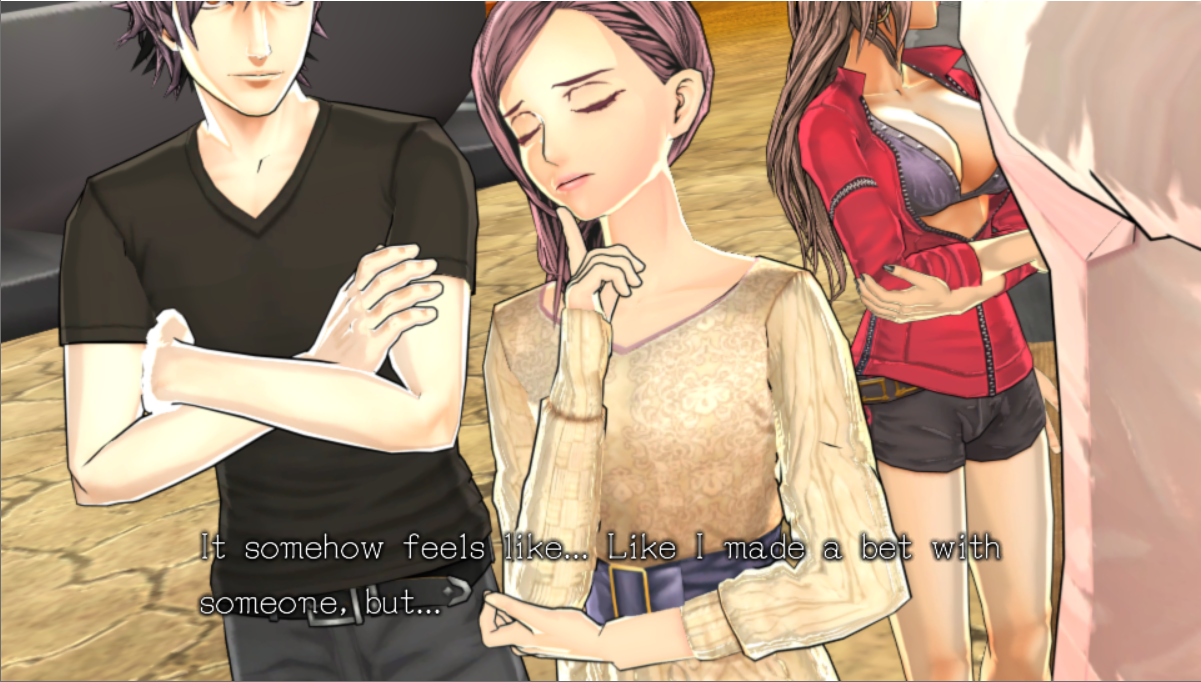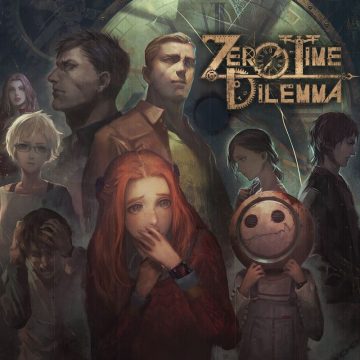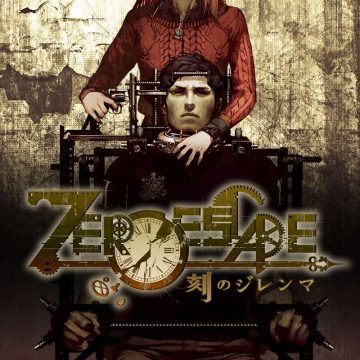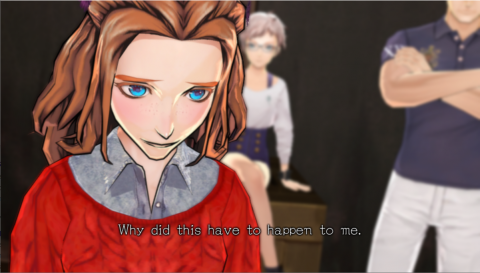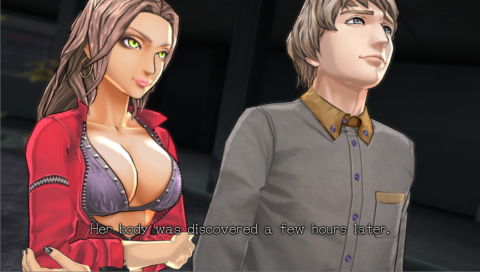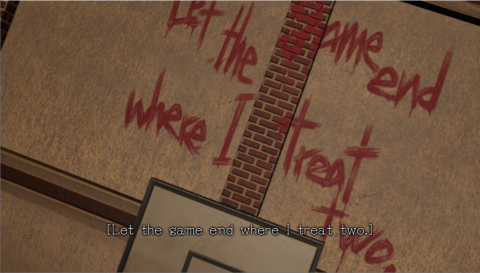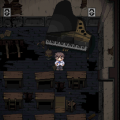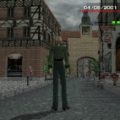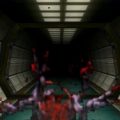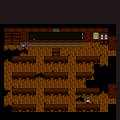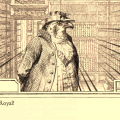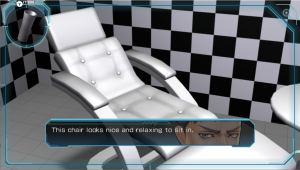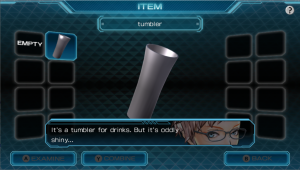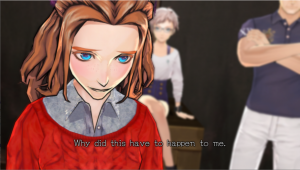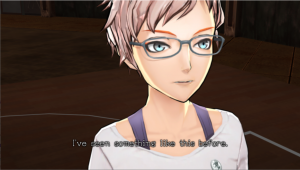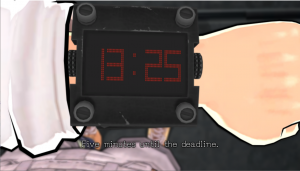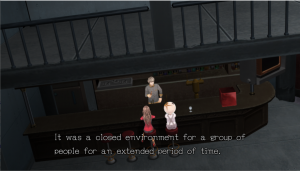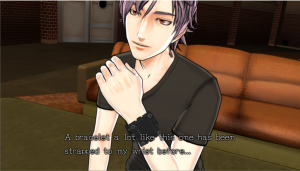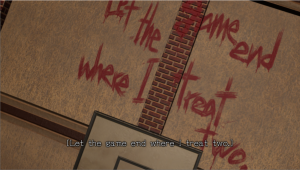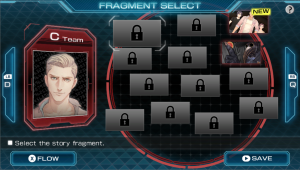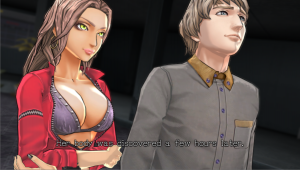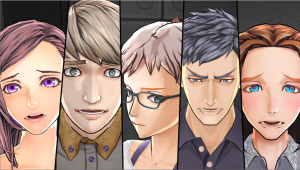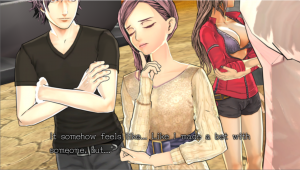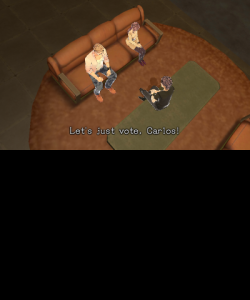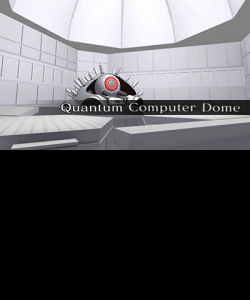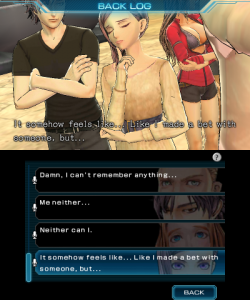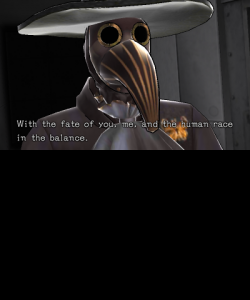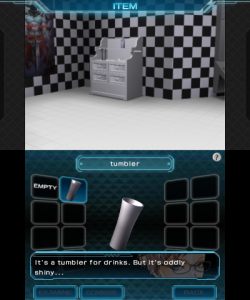Following the release of Virtue’s Last Reward, Uchikoshi encouraged fans on social media to continue supporting the game and asking for a third episode. Thanks to the fans (as the last screen of the credits reminds us), Zero Time Dilemma was announced in the summer of 2015, and was released in the next year in 2016. Ostensibly the last episode of the Zero Escape trilogy, it had quite a lot to live up to given the quality set by its predecessors. While definitely a step down, it is still a worthy episode to close the series.
At the end of Virtue’s Last Reward, the heroes had a clear path forward – to prevent the tragic events they uncover, they must go back in time, to a mysterious experiment in a compound during which something happened that triggered the fateful events. Zero Time Dilemma is set in this compound: the group is promptly kidnapped by Zero, who forces them, once again, to play a game of life or death. However, the setup is a bit different – instead of embodying a protagonist, here the player’s perspective is external, viewing the characters as in a movie. The characters are split into 3 groups, with the player able to follow each group. In fact, the game very quickly unlocks a number of vignettes, that you must explore to piece together what is happening and unlock more vignettes. Much like in Virtue’s Last Reward, where exploring all components of the flowchart was a necessity, but here, the vignettes can be explored in any order. Once again, the series’ experimentation with form and meta-narrative is interesting, and the gradual realization of which pieces fit together chronologically is a fun puzzle.
Characters
Team C
Carlos
the leader of Team C, he is a brave firefighter with a strong sense of justice. Has been caring for his sick sister, who means the world to him.
Junpei
No longer the young bright-eyed protagonist, the events of 999 have changed him into a deeply bitter, jaded man.
Akane
A bit more mature than in 999, and it is now clear that behind the innocent facade of a nice young lady hides a character with way more moral ambiguity.
Team Q
Q
The leader of Team Q, he is ostensibly a small child whose head got stuck in an unmovable helmet. He has no memories of who he is and is frequently picked on by Eric.
Eric
A weak-willed young man who can become quite nasty in stressful situations. In a relationship with Mira, whom he’s very in love with.
Mira
A beautiful young woman with a cool, detached, and maybe even manipulative behavior.
Team D
Diana
The leader of Team D. As in Virtue’s Last Reward, a kind, pacific young woman who will always think of the team first.
Phi
Similarly to Virtue’s Last Reward, abrasive serious smart Phi is effortlessly cool, but do not get in her path. Joined the experiment to try to save the world.
Sigma
A 22 year-old man who has lived for longer than that. Brave and driven, more mature than in VLR, he will do what it takes to protect people and save the world, along with his good friend Phi.
Zero
Once again a shadowy figure organizing the Nonary Game for unknown reasons. Zero wears a plague doctor mask in this iteration.
The game even has an interesting conceit to justify seeing the vignettes in any order: at the end of most vignettes, Zero injects sleep-inducing and memory loss drugs in the characters’ veins, making them unable to remember previous events, or to even know how many times they have woken up since the original events. This means the vignettes are essentially independent from each other, making the experience truly non-linear past the first hour. Most vignettes incorporate an escape room, and usually a shocking, often gruesome, discovery. This means that the player will quickly see an action scene, with mysterious elements, and perhaps some deaths, making the experience more immediately gripping than Virtue’s Last Reward.
However, there is a big drawback to this approach – with repeated amnesia, there is no reference to past vignettes by the characters (and in fact, they end up saying similar lines numerous times, like “we don’t even know how many times we have woken up!”), and very little changes to the characters, or deepening of their relationships. The cast incorporates some characters from 999 and some from Virtue’s Last Reward (all of whom have infiltrated the experiment to find Zero) as well as a few completely new characters. However, characters from previous games sometimes do not have the same personality, and past events (in particular, 999‘s big reveal, and the plan from Virtue’s Last Reward which served as a cliffhanger into this third episode) are only very vaguely referenced and, inconsistently, not as important as they should be. This is probably a good thing to onboard new players, or maybe that the series’ complicated lore and plotlines would make the whole thing crumble under its own weight. As for the additional characters, they are unfortunately not only a step down from the other, iconic cast members, but also not very interesting in themselves; their characterization is shallow and the secrets they reveal are very melodramatic and somewhat clichéd. (In particular, one of the three teams is made entirely of new characters that are universally viewed as grating or unsympathetic, making the corresponding vignettes a bit of a chore.)
This is compounded by the game’s presentation issues. The game opts this time for an “interactive movie” presentation, obviously inspired by Telltale (in particular The Walking Dead, says Uchikoshi), with a dynamic camera “filming” the 3D characters and lines flowing automatically, instead of the other two episodes’ visual novel conventions, i.e. sprite animations and lines that need to be triggered by the player. Unfortunately, the 3DS version is a major step down compared to the others, with simplified models, less shading/depth of field, no use of the 3DS’s 3D effect, and despite all of this, slow loading times, of 5-7 seconds with every new environment, which can break the rhythm when happening several times in a row. That being said, no matter the version, the 3D cell-shaded characters do not look great: their eyes are big and mostly soulless, and their expressions are fixed for the duration of the shot, creating a jarring effect when one character plays an angry animation while others just look on. You do get used to it after a while, but it still takes away from the game.
The animations themselves are very often on the robotic side (think The Sims from 1999), save for a few ones in specific action scenes. This starkly highlights the comparative difficulty of 2D and 3D – 3D interactive movies are compared by players’ brains to movies and reality, which is a high bar to clear, while visual novels are not perceived as realistic and will get away with more limited sprite work. Another point is pacing: VNs will wait for the player to trigger the next line (which means players accept the artificial pacing and can replay the conversation in their heads), but pacing is important in an interactive movie. The pacing is decent enough in every version except the 3DS version, whose pacing is terrible, with (presumably) loading issues creating an unnaturally long pause between each line. Regardless, the direction/editing is not great: the camera mostly switches angles with every single line, and resorts to employing slow, creepy zoom effects with the camera tilted at an angle to try to make things interesting while most of the characters’ body language is frozen in place.
The characters are somewhat saved by their dubbing, which is of very high quality, just as for the other episodes of the series; apart from a couple of weaker characters, their personality shines through, and the direction of the voice actors is very good. The general consensus seems to be once again that the English dubbing is on par with the Japanese dubbing, which is high praise; either language can be selected in the game’s options. As for the music, it has some very good tracks (including some reinventions of themes from the previous episodes), but it might overall be a bit weaker and less memorable than the previous episodes’; in particular, some of the themes are overused, including the two “melancholic piano” themes that show up every time a character tells a sad story.
The play time is longer than 999, but shorter than Virtue’s Last Reward, which is far from a bad thing. The escape rooms, once again made of mostly sci-fi-themed environments with puzzles with a mathematical bent, are fewer than Virtue’s Last Reward, but they are arguably even better as a whole. While some rooms are not very interesting (with “just copy the clue you found elsewhere” the biggest offender), there are more that incorporate multi-step searches, or complicated machinery and systems that need to be understood to be manipulated; they mostly remain fair to the player, with fewer “read-the-designer’s-mind” moments (the “hard/easy mode” of Virtue’s Last Reward is gone, too), and satisfactory answers. While their justification in the story is even flimsier than before, it is at this point a tradition of the series, and it is really hitting its stride in this episode.
One problem in the previous episodes was that the escape rooms could become chores that interrupted a very interesting story and juicy revelations. This is mostly not an issue here… but not in a good way. 999 had an increasing body count and a very rich mechanic that drove the plot, while Virtue’s Last Reward had decision games that explored the consequences of breaking trust. In contrast, Zero Time Dilemma does not have an overarching theme, and this is again partly a consequence of the “vignette, then amnesia” conceit, which means the events and consequences of a vignette mostly do not affect characters in any other vignette; but also of the fact that the characters are split up into three independent groups, meaning there are fewer combinations / relationships and depth. In practice, until a significant portion through the game, it can feel like the player is just supposed to select a piece of content, see shocking events, and move on to the next vignette on the “to do” list. There are no obvious consequences, no overarching question or theme, fewer mysteries, and fewer reveals – in particular, much fewer of the intermediate reveals that explained part of the mysteries but left you hanging on bigger questions. There is also fewer of the big decisions that the previous games relied on; the game does try to set up some choices as moral quandaries, but the drama behind them is sometimes undercut by the fact that the player has seen what another team really did/meant, and by the fact that one of the answers leads to a quick “game over”.
The story finally kicks into next gear in the last six hours or so, but even then, doesn’t do it in an entirely satisfactory way. Here, it introduces a plot point that feels like a convenient way to solve issues for the writer, but brings with it many other possibilities and inconsistencies. The plot point is crucial to a particular ending, which lasts almost an hour, and is extremely melodramatic with no immediate sense of why this ending needed to happen. The game then ramps up as the characters start to understand what is going on and attempt various strategies to get out of the compound; at this point, you end up revisiting some “big decisions” that were framed as an open question (“type the answer!”) instead of a multiple choice, and piece together what the answers should be, to unlock more fragments. Which leads to the big plot twist.
Uchikoshi has stated that, for all the games of the series, he always starts by figuring out a good plot twist, then works backwards. And indeed, the twists for 999 and Virtue’s Last Reward were very inventive, culminating in a moment where the main character realizes something shocking, that hinges on something the player had written off as inconsequential or a product of the genre. In Zero Time Dilemma, there are fewer shocking twists in the railroaded final act – and unfortunately, the big final plot twist does not land. Contrary to the previous episodes, this plot twist has numerous people feel, with reason, that it is cheap and unfair, introducing something new completely out of the blue, which hinges on the game essentially lying to you for twenty hours and steering some scenes a certain way so you don’t notice anything. Some clues are dropped throughout the game, but they are extremely subtle, and it is unlikely you get the satisfying “oh! that’s why!” moment after the twist is revealed. Whether it is fair game or not is still up for debate, but one thing is certain – it’s a noticeable step down from the previous episodes.
This would essentially sum up Zero Time Dilemma – it’s very hard to follow 999 and Virtue’s Last Reward, and the game certainly has qualities, especially with still excellent voice acting, a bold story structure, and escape rooms that are even better than in the previous episode. However, the presentation issues are a letdown, making the game look and feel worse than the previous 2D episodes. But even if you can get past it, the game’s story lacks a consistent theme or drive, and the final act, usually the best part, ends up being contrived and not very satisfying, with a resolution that doesn’t to much of anything. Fans will want to play the game to see some of Uchikoshi’s answers to the series’ questions, but it certainly doesn’t represent as effective a gateway into the Zero Escape series as the other episodes.
